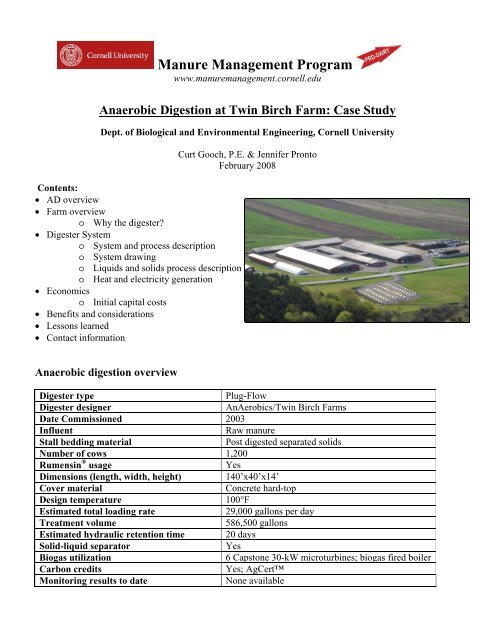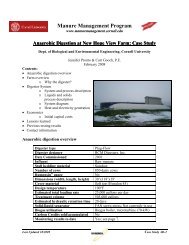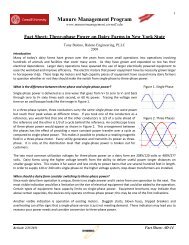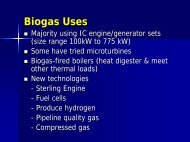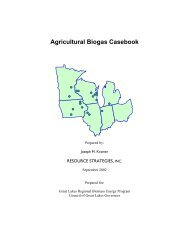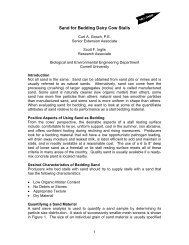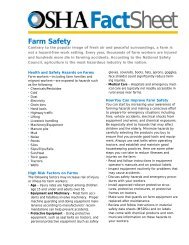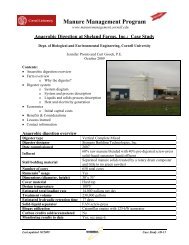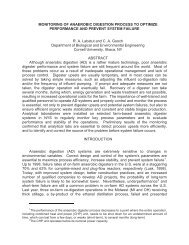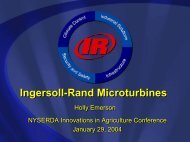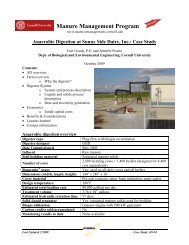Anaerobic Digester at Twin Birch Farms - Manure Management ...
Anaerobic Digester at Twin Birch Farms - Manure Management ...
Anaerobic Digester at Twin Birch Farms - Manure Management ...
You also want an ePaper? Increase the reach of your titles
YUMPU automatically turns print PDFs into web optimized ePapers that Google loves.
<strong>Manure</strong> <strong>Management</strong> Program<br />
www.manuremanagement.cornell.edu<br />
<strong>Anaerobic</strong> Digestion <strong>at</strong> <strong>Twin</strong> <strong>Birch</strong> Farm: Case Study<br />
Dept. of Biological and Environmental Engineering, Cornell University<br />
Contents:<br />
• AD overview<br />
• Farm overview<br />
o Why the digester?<br />
• <strong>Digester</strong> System<br />
o System and process description<br />
o System drawing<br />
o Liquids and solids process description<br />
o He<strong>at</strong> and electricity gener<strong>at</strong>ion<br />
• Economics<br />
o Initial capital costs<br />
• Benefits and consider<strong>at</strong>ions<br />
• Lessons learned<br />
• Contact inform<strong>at</strong>ion<br />
Curt Gooch, P.E. & Jennifer Pronto<br />
February 2008<br />
<strong>Anaerobic</strong> digestion overview<br />
<strong>Digester</strong> type<br />
Plug-Flow<br />
<strong>Digester</strong> designer<br />
AnAerobics/<strong>Twin</strong> <strong>Birch</strong> <strong>Farms</strong><br />
D<strong>at</strong>e Commissioned 2003<br />
Influent<br />
Raw manure<br />
Stall bedding m<strong>at</strong>erial<br />
Post digested separ<strong>at</strong>ed solids<br />
Number of cows 1,200<br />
Rumensin ® usage<br />
Yes<br />
Dimensions (length, width, height) 140’x40’x14’<br />
Cover m<strong>at</strong>erial<br />
Concrete hard-top<br />
Design temper<strong>at</strong>ure 100°F<br />
Estim<strong>at</strong>ed total loading r<strong>at</strong>e<br />
29,000 gallons per day<br />
Tre<strong>at</strong>ment volume<br />
586,500 gallons<br />
Estim<strong>at</strong>ed hydraulic retention time 20 days<br />
Solid-liquid separ<strong>at</strong>or<br />
Yes<br />
Biogas utiliz<strong>at</strong>ion<br />
6 Capstone 30-kW microturbines; biogas fired boiler<br />
Carbon credits<br />
Yes; AgCert<br />
Monitoring results to d<strong>at</strong>e<br />
None available
Farm overview<br />
• <strong>Twin</strong> <strong>Birch</strong> Farm is a 1,200-cow dairy oper<strong>at</strong>ion loc<strong>at</strong>ed close to the Village of Owasco in Cayuga<br />
county, New York<br />
• The farm is owned and managed by Dirk Young.<br />
• Construction of the digester began in 2001; after overcoming equipment difficulties, the digester was<br />
successfully commissioned in September 2006 and the microturbines started producing power in<br />
January 2007.<br />
• The digester was funded in part by the NYS Clean W<strong>at</strong>er, Clean Air Act and in part by NYSERDA<br />
• <strong>Digester</strong> effluent separ<strong>at</strong>ion, use of separ<strong>at</strong>ed manure solids for bedding, and pumping separ<strong>at</strong>ed liquid to<br />
a remote storage have all been successful.<br />
• The farm has acted as its own designer and general contractor after the original system designer failed to<br />
perform.<br />
Why the digester?<br />
The farm is loc<strong>at</strong>ed across from a golf course and in two sensitive w<strong>at</strong>ersheds (Skane<strong>at</strong>eles and Owasco<br />
lakes, both heavily used for recre<strong>at</strong>ion and w<strong>at</strong>er supply for Syracuse, NY and Auburn, NY respectively).<br />
<strong>Manure</strong> was traditionally managed by weekly spreading from short-term storages under the barns onto crop<br />
fields. W<strong>at</strong>ershed recommend<strong>at</strong>ions as part of a CAFO plan, as well as the desire to limit spreading on<br />
s<strong>at</strong>ur<strong>at</strong>ed soils for environmental and compaction reasons, led the farm to install a 6-million gallon manure<br />
storage pond. It was known th<strong>at</strong> storing the manure long-term and subsequently spreading on a large portion<br />
of cropland would cre<strong>at</strong>e significant odor issues in the community.<br />
Recommend<strong>at</strong>ions were made by the Cayuga County Soil and W<strong>at</strong>er Conserv<strong>at</strong>ion District and the<br />
Skane<strong>at</strong>eles Lake W<strong>at</strong>ershed Agricultural Program for both long-term storage and odor control. Some<br />
funding was available from New York St<strong>at</strong>e’s non-point funding program to implement conserv<strong>at</strong>ion<br />
practices, including an anaerobic digester. The potential for odor control, and anticip<strong>at</strong>ed revenue from<br />
energy and compost production, motiv<strong>at</strong>ed the farm to construct a digester. NYSERDA funding th<strong>at</strong><br />
provided cost-share opportunities for innov<strong>at</strong>ive agricultural energy recovery practices, led the farm, along<br />
with the anticip<strong>at</strong>ion of reduced long-term oper<strong>at</strong>ing costs (compared to internal combustion engines), to<br />
choose microturbines for the power gener<strong>at</strong>ion system.<br />
The project goals were to install a digester system th<strong>at</strong> could demonstr<strong>at</strong>e cost-effectiveness and provide the<br />
following benefits:<br />
• Odor reduction<br />
• Energy production (using microturbines)<br />
• Separ<strong>at</strong>ed manure solids for bedding<br />
• Purchased he<strong>at</strong> savings<br />
2<br />
________________________________________________________________________________________________________<br />
Last Upd<strong>at</strong>ed 10/2009<br />
Case Study AD-8
<strong>Digester</strong> System<br />
System and process description<br />
The <strong>Twin</strong> <strong>Birch</strong> digester system is composed of several components:<br />
• <strong>Manure</strong> collection<br />
• External shell and tube he<strong>at</strong> exchanger<br />
• Hair-pin plug-flow digestion<br />
• Separ<strong>at</strong>ion of post-digested effluent<br />
• Separ<strong>at</strong>ed manure solids used as bedding<br />
• Pump separ<strong>at</strong>ed liquid effluent to remote long-term storage<br />
3<br />
The digester, a below-grade rectangular insul<strong>at</strong>ed concrete tank, was designed with a hard top to develop a<br />
rel<strong>at</strong>ively high biogas pressure. Initially, the concrete top formed the base for the equipment room, which<br />
was in turn covered with a fabric-cladded metal arch structure. The equipment room formerly housed the<br />
gas dew<strong>at</strong>ering and compression equipment along with the microturbines, boiler and he<strong>at</strong> exchanger.<br />
Unstoppable biogas leaks in the concrete top led to the corrosion of several equipment components, and the<br />
decision was made to move the equipment to a separ<strong>at</strong>e structure, which was l<strong>at</strong>er constructed about 100 feet<br />
away from, instead of above, the digester.<br />
South Freestall<br />
Dry<br />
cows<br />
and<br />
heifers<br />
Milking center<br />
North Freestall<br />
Influent pit<br />
Separ<strong>at</strong>ed solids<br />
<strong>Digester</strong> influent<br />
Separ<strong>at</strong>ed<br />
manure<br />
solids<br />
storage<br />
Solids-Liquid<br />
separ<strong>at</strong>or<br />
Hair-pin plug flow anaerobic digester<br />
Separ<strong>at</strong>ed liquid<br />
Long term<br />
storage<br />
Separ<strong>at</strong>ed liquid effluent<br />
Biogas<br />
Hot w<strong>at</strong>er<br />
Gas utiliz<strong>at</strong>ion bldg.<br />
Boiler<br />
Flare<br />
MT<br />
30-kW<br />
MT<br />
MT<br />
30-kW<br />
MT<br />
Gas<br />
compressor<br />
30-kW<br />
MT<br />
30-kW<br />
30-kW<br />
MT<br />
30-kW<br />
He<strong>at</strong> exchanger<br />
Exhaust<br />
________________________________________________________________________________________________________<br />
Last Upd<strong>at</strong>ed 10/2009<br />
Case Study AD-8
Liquids and solids process description<br />
<strong>Digester</strong> influent is comprised of 1,200 dairy animals worth of manure, manure from older heifers and some<br />
beef c<strong>at</strong>tle, milking center wastew<strong>at</strong>er, and used bedding. <strong>Digester</strong> influent is pumped from a centralized<br />
collection pit loc<strong>at</strong>ed in the connection barn between the north freestall barn and the milking center to the<br />
digester on a 12 minute cycle, every 3 minutes pumping influent.<br />
Influent is warmed to digester oper<strong>at</strong>ing temper<strong>at</strong>ure with a shell and tube he<strong>at</strong> exchanger. No maintenance<br />
he<strong>at</strong> is added to the digester. Field measurements performed by the farm show the effluent is about 3°F less<br />
than the influent. The digester has a longitudinally oriented divider wall resulting in a hair-pin configur<strong>at</strong>ion;<br />
digester influent and effluent enter and exit the digester on the same end-wall of the digester.<br />
Digested effluent is pumped to a FAN screw-press solid-liquid separ<strong>at</strong>or (SLS) with SLS liquid effluent<br />
pumped by a 160-Hp centrifugal pump to a remote earthen storage 7,500 feet away with a 220 feet increase<br />
in elev<strong>at</strong>ion. The separ<strong>at</strong>ed solids are stacked in a roofed area and either used for freestall bedding, sold or<br />
recycled to the land base.<br />
He<strong>at</strong> and electricity gener<strong>at</strong>ion<br />
Biogas is used to fuel:<br />
1) a 900,000-Btu duel-fuel boiler (also runs on No.2 fuel oil)<br />
2) six 30-kW Capstone microturbines<br />
Excess biogas is currently combusted by a flare.<br />
The duel-fuel boiler is used as the secondary means to he<strong>at</strong> the hot w<strong>at</strong>er circul<strong>at</strong>ion loop th<strong>at</strong> provides the<br />
he<strong>at</strong> source to the shell and tube he<strong>at</strong> exchanger. (The primary means is the combustion he<strong>at</strong> recovered from<br />
the microturbine exhaust gas.) Start-up he<strong>at</strong> was supplied by firing the 900,000 Btu dual-fuel boiler with fuel<br />
oil.<br />
Biogas destined for use by the bank of microturbines first goes thru a multi-step dew<strong>at</strong>ering process and is<br />
subsequently compressed to about 90 psi.<br />
For the month of January 2008 the average daily metered biogas production was 115,086 ft 3 per day with a<br />
calcul<strong>at</strong>ed methane (CH 4 ) content of 58%. For this same time period, the farm averaged 1,995 total animals<br />
feeding the digester; the corresponding gas production per animal was 57.7 ft 3 /cow/day.<br />
4<br />
________________________________________________________________________________________________________<br />
Last Upd<strong>at</strong>ed 10/2009<br />
Case Study AD-8
Benefits and Consider<strong>at</strong>ions<br />
Benefits<br />
• Odor control<br />
• Potential revenue from:<br />
1) Value-added products<br />
2) Reduction of purchased energy<br />
3) Sales of excess energy<br />
4) Efficient use of biogas production<br />
5) Carbon credit sales<br />
• Nutrient conversion, allowing use by<br />
plants as a n<strong>at</strong>ural fertilizer, if effluent is<br />
spread <strong>at</strong> an appropri<strong>at</strong>e time<br />
• P<strong>at</strong>hogen reduction<br />
Consider<strong>at</strong>ions<br />
• Possible high initial capital and/or high<br />
oper<strong>at</strong>ing costs<br />
• Long and tedious contracts with the local<br />
utility; may require special equipment for<br />
interconnection<br />
• Dedic<strong>at</strong>ed management of the digestion<br />
system is required<br />
• Careful <strong>at</strong>tention to equipment<br />
maintenance and safety issues due to the<br />
characteristics of raw biogas<br />
5<br />
Lessons Learned<br />
The farm has overcome many difficulties and obstacles in order to order to meet success. The following are<br />
some of the major problems they encountered, and lessons th<strong>at</strong> were learned as a result of oper<strong>at</strong>ing their<br />
anaerobic digester system.<br />
<strong>Digester</strong> designer<br />
Choosing an engineering company to design and construct the digester can be confusing. Each company has<br />
different ideas on the type of digester, gas collection, gas cleaning, power system, electric hookup, and<br />
he<strong>at</strong>ing system. Each company has to have the capacity, tenacity and range of expertise to put a complex<br />
system together on a farm. Comparing companies with different pricing schemes, sales pitches, and<br />
promises can be difficult. Many seemingly little issues become big issues when they cause the whole system<br />
to fail. It is important to review the experiences and references of the engineers carefully, paying particular<br />
<strong>at</strong>tention to their work on similar projects.<br />
Engineering companies have to put together various disciplines to design a digestion system. Drains to<br />
control the w<strong>at</strong>er table around the digester to prevent buoyancy of the empty digester and to control he<strong>at</strong> loss<br />
were not included in the initial design. Uplifting and excessive cooling were prevented by adding well<br />
positioned drainage pipes after construction. The w<strong>at</strong>er and gas pressure was compromised. All in-ground<br />
structures should have drainage systems in the backfill to reduce he<strong>at</strong> loss and prevent flo<strong>at</strong><strong>at</strong>ion.<br />
Hard top to contain biogas<br />
The digester was designed with a hard top with the goal of developing 12 inches of w<strong>at</strong>er column biogas<br />
pressure to force biogas into the compressor. The compressor is needed to increase biogas pressure to<br />
microturbine target inlet to pressure to 90 psi. Difficulties in sealing the concrete top led to biogas leaks and<br />
partially digested by-products. Biogas leaks caused odor problems, and since the equipment building was<br />
initially loc<strong>at</strong>ed on top of the digester, leaking biogas cre<strong>at</strong>ed both a safety problem and corrosion of<br />
electronic equipment.<br />
A blower and control system was installed in an <strong>at</strong>tempt to keep the biogas pressure in the digester gas head<br />
space neutral to minimize biogas leakage; however, when equipment fails, gas still leaks causing odor<br />
emissions. The gre<strong>at</strong>er the pressure the more difficulties there are in sealing a digester. <strong>Digester</strong>s oper<strong>at</strong>ed<br />
________________________________________________________________________________________________________<br />
Last Upd<strong>at</strong>ed 10/2009<br />
Case Study AD-8
6<br />
<strong>at</strong> high pressures should be pressure-tested as part of the start up procedure. Use proven technologies to<br />
seal digesters. Separ<strong>at</strong>e any equipment as much as possible from biogas sources.<br />
He<strong>at</strong>ing system<br />
Oper<strong>at</strong>ional experience revealed th<strong>at</strong> the digester he<strong>at</strong>ing system had several initial flaws. The he<strong>at</strong><br />
exchanger was sized too small to he<strong>at</strong> incoming manure to 100°F. Groundw<strong>at</strong>er s<strong>at</strong>ur<strong>at</strong>ing the insul<strong>at</strong>ion<br />
outside the digester increased he<strong>at</strong> loss.<br />
These issues were partially overcome with the addition of a larger he<strong>at</strong> exchanger and drainage around the<br />
digester. Possibly he<strong>at</strong> pipes added inside digester walls during construction would have been able to<br />
maintain temper<strong>at</strong>ures in the digester. The he<strong>at</strong> balance of the digester system is vital. Designs need to<br />
address he<strong>at</strong> recovery from the biogas, methods to he<strong>at</strong> the incoming manure, and correct estim<strong>at</strong>es of the<br />
maintenance he<strong>at</strong> are needed to maintain a constant temper<strong>at</strong>ure in all we<strong>at</strong>her conditions.<br />
Biogas to electrical energy conversion<br />
Microturbines are sensitive to biogas pressure and the fuel r<strong>at</strong>io (methane concentr<strong>at</strong>ion) can range widely.<br />
Microturbines have complex, sensitive electronics controlling their oper<strong>at</strong>ion. Microturbines may have<br />
significant advantages over some internal combustion engines (including energy conversion efficiency,<br />
lower maintenance, higher exhaust temper<strong>at</strong>ures, and lower noise), depending on the goals of the farm. The<br />
farm’s microturbines ran successfully in a test mode before the biogas compressor failed; however, until the<br />
recent past, they have not provided the ease of oper<strong>at</strong>ion th<strong>at</strong> perhaps an engine gener<strong>at</strong>or would have.<br />
The majority of the problems experienced in the past with microturbines <strong>at</strong> this site were due to the corrosive<br />
environment cre<strong>at</strong>ed by the leaking concrete top. The electronics had to be replaced after being in a<br />
corrosive gas environment prior to start-up. Also, the initial biogas compressors failed despite specific<strong>at</strong>ions<br />
for biogas use. Bottom line for this topic: select a reliable power system and learn as much as you need to<br />
ensure its successful oper<strong>at</strong>ion. Dirk Young <strong>at</strong>tended a weeklong training session to be certified to oper<strong>at</strong>e<br />
the microturbines.<br />
Project cost estim<strong>at</strong>e<br />
The cost estim<strong>at</strong>e for this project was under $500,000. The actual cost to d<strong>at</strong>e has been over $1,300,000.<br />
Get realistic cost estim<strong>at</strong>es and include plans for contingencies.<br />
Who to Contact<br />
• Dirk Young, Owner, <strong>Twin</strong> <strong>Birch</strong> <strong>Farms</strong>, 1001 Lacy Road Skane<strong>at</strong>eles, NY. Phone: 315-784-5840,<br />
e-mail: dyoung@baldcom.net<br />
• Curt Gooch, <strong>Manure</strong> Tre<strong>at</strong>ment Specialist, PRO-DAIRY Program, Cornell University.<br />
Phone: 607-255-2088, e-mail: cag26@cornell.edu<br />
Acknowledgements<br />
The authors would like to thank the New York St<strong>at</strong>e Energy Research and Development Authority (NYSERDA) for funding in support of this work. Any<br />
opinions, findings, conclusions or recommend<strong>at</strong>ions expressed in this public<strong>at</strong>ion are those of the authors and do not necessarily reflect the views of<br />
NYSERDA or the St<strong>at</strong>e of New York, and reflect the best professional judgment of the authors based on inform<strong>at</strong>ion available as of the public<strong>at</strong>ion d<strong>at</strong>e.<br />
Reference to any specific product, service, process, or method does not constitute an implied or expressed recommend<strong>at</strong>ion or endorsement of it. Further,<br />
Cornell University, NYSERDA and the St<strong>at</strong>e of New York make no warranties or represent<strong>at</strong>ions, expressed or implied, as to the fitness for particular purpose<br />
or merchantability of any product, appar<strong>at</strong>us, or service, or the usefulness, completeness, or accuracy of any processes, methods, or other inform<strong>at</strong>ion<br />
contained, described, disclosed, or referred to in this public<strong>at</strong>ion. Cornell University, NYSERDA and the St<strong>at</strong>e of New York make no represent<strong>at</strong>ion th<strong>at</strong> the<br />
use of any product, appar<strong>at</strong>us, process, method, or other inform<strong>at</strong>ion will not infringe priv<strong>at</strong>ely owned rights and will assume no liability for any loss, injury, or<br />
damage resulting from, or occurring in connection with, the use of inform<strong>at</strong>ion contained, described, disclosed, or referred to in this public<strong>at</strong>ion.<br />
________________________________________________________________________________________________________<br />
Last Upd<strong>at</strong>ed 10/2009<br />
Case Study AD-8


